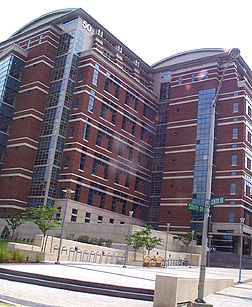| T
H E N I H C A T A L
Y S T |
J U L Y – A
U G U S T 2001 |
|
 |
|
‘By
Act of Congress
This building is designated as
THE LOUIS STOKES LABORATORIES
Congressman Louis Stokes served as a distinguished member of the United
States Congress for 30 years, representing his native State of Ohio. He
was elected to the House Appropriations Committee in 1971, and served
on the House Appropriations Subcommittee on Health and Human Services,
where he was a strong proponent of biomedical research. His dedicated
service to the nation is marked by hard work and a commitment to fairness.
His unwavering support of the National Institutes of Health is defined
by judicious advocacy and a determination that through research NIH can
help eliminate disparities in health among the country’s minority,
poor, underserved and disadvantaged communities.’
|
Add
buildings 2, 3, 7, and some of 6 and you get 50—clearly the whole is greater
than the sum of its parts.
Building 50—the Louis
Stokes Laboratories—was officially welcomed onto the NIH campus in June
in a ceremony enlivened by jazz combos, former HHS secretary Louis Sullivan,
and Congressman Stokes himself. This most recent NIH edifice will be home to
intramural scientists from NIDDK, NHLBI, NIAID, NIAMS, NHGRI, NIDCD, and NCI—as
well as the labs of the new NEI director, Paul
Sieving, and the new NIDCR director, Lawrence
Tabak.
All told, there are 253
lab modules in Building 50—ranging from 37 to 44 on each of its six floors
and arranged in neighborhood clusters. The essence of the research to be conducted
in the building is structural and cell biology and microbiology; the essence
of its design is to facilitate collaboration. The ease of interaction with colleagues
who are "asking similar biological questions" was extolled by Maria
Morasso of NIAMS and John
Carpten of NHGRI,
two tenure-track investigators who could well bump into one another in Building
50 during their respective explorations into the molecular basis of inherited
disease and the molecular basis of normal development.
As of early July, floors
2, 3, and most of 4 were occupied; by September’s end, the remaining floors
will be filled with the estimated 650 people assigned Building 50 space, more
than 600 of whom are scientists, according to the building’s award-winning
design and construction project officer, Frank
Kutlak.
A state-of-the-art vivarium,
in the basement, is managed by NIAID but used by all the institutes, with their
allotted space proportional to the square footage of their lab space in the
building.
An NMR suite is shared
by Ad Bax of
NIDDK and Jim
Ferretti of NHLBI, and an electron microscopy suite is shared by Alasdair
Steven of NIAMS
and Sriram Subramaniam
of NCI. 
For a Building 50 history,
go to this website.
Return to Table of Contents
